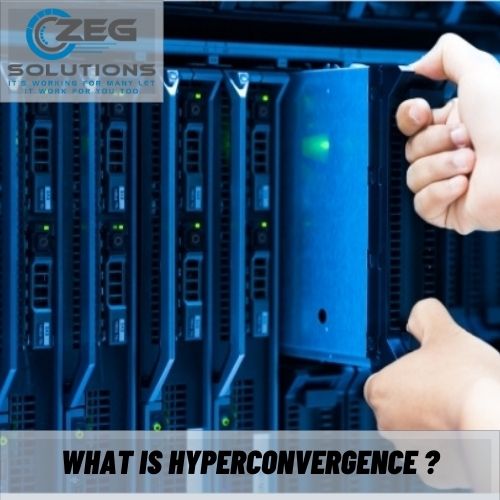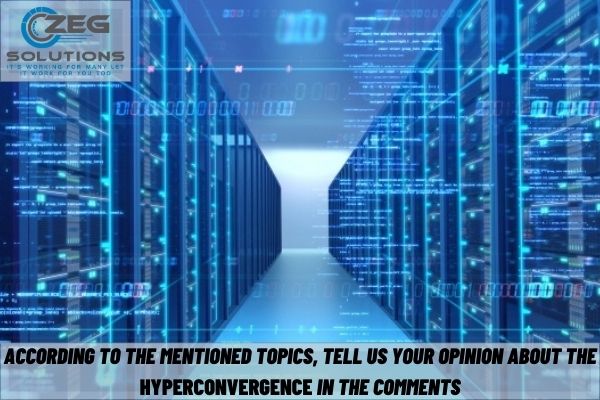Have you ever heard about hyper-convergence? No? You should.
The demands of corporate IT are increasing continuously. Even larger amounts of data have to run over the servers in a shorter period, without any more budget being available. This is why hyper-converged systems are currently in high demand in the IT infrastructure sector. Today data centers usually work with central storage systems. Hyper-converged infrastructure (HCI), on the other hand, is based on standard hardware, computers with built-in hard drives or SSDs. This structure’s significant advantage is that everything can be managed from one place: virtualization, network, and storage.
What is hyper-converged infrastructure?
“Convergence” initially only means that several things come together at one point. It is how convergent infrastructures work: Various IT components are combined into a package. Convergence to hyper-convergence has been further developed in recent years. The steps from traditional infrastructure to HCI follow a clear guideline: more efficiency through simplification.

How is the traditional IT infrastructure structured?
A company’s data center typically consists of several components: Network, Storage, Compute, and (in the best case) backup/disaster recovery. All sub-aspects run separately from one another, on different hardware, and with individual software solutions. Administrators manage the components independently of one another. The complexity and individuality of the individual parts make the use of specialists necessary. A network administrator is not able to take over storage management at the same time.
If properly managed and maintained, an IT company structured in this way is a reliable system that is very easy to work with. Simultaneously, it is very rigid and can only be changed with a lot of effort. New components are expensive, which is why officials usually only buy them in longer cycles. If existing resources are no longer eligible, newly purchased equipment should be used for at least the next few years. Capacity is provided in advance and not as needed.
Such a system is also sensitive to changes. When setting up the IT, administrators spend much energy and nerves coordinating all elements to work smoothly. New components must therefore be introduced with care because otherwise, they could disturb the technical equilibrium.
From traditional to convergent infrastructure
In comparison, in convergent structures, the individual components are more closely united in a common framework, a so-called appliance. The members generally remain independent of one another but work hand in hand together. They are already coordinated in advance by the complete system provider, so that smooth interaction is guaranteed. IT no longer has to deal with the laborious adjustment of the individual hardware parts.
Convergent systems also have organizational advantages:
Convergent systems generally ensure more order in the server room. The different hardware components are housed in server cabinets with direct connections to each other. Nevertheless, there remain independent individual parts that have to be maintained – by the relevant personnel. When the time has come to upgrade the hardware, extensions cannot only be added. The entire system has to be adapted. In this aspect, convergent systems do not differ from their classic predecessors.
Virtualization developments
The current state of affairs is called virtualization. Instead of creating unique physical environments, administrators create virtual levels in which they provide servers, storage, and networks. Different servers can run on just one platform. It ensures that resources can be used much better. Instead of many individual hardware solutions, the virtual environment’s resources are available for the entire system. A hypervisor (i.e., the abstracting intermediate level) distributes the resources evenly to the individual components. Fast communication between the members involved is essential for functioning virtualization. For example, virtual machines also need storage networks. The so-called LUNs (Logical Unit Numbers) can be simple hard disks and parts of the general storage network. Either way, the setup must be done by a storage specialist and not by the virtualization administrator. It leads to slowdowns in work processes.
Also, the so-called I / O blender effect is a problem that administrators have been struggling with for a long time: All virtual machines (with Virtual Desktop Infrastructure, for example) send their requests (input/output) to the hypervisor, and there they become like mixed in a mixer (blender). As a result, the storage media take longer to find the requested data. It ultimately leads to a loss of speed in data transmission.
Components for hyper-convergence
A hyper-converged infrastructure includes the following components, among others:
- integrated virtualization (hypervisor)
- virtualized storage (software-defined storage)
- virtualized network (software-defined networking)
- Control software
How does HCI work?
Hyper-convergent systems were created to meet the new challenges facing corporate IT, increasing virtualization. The principle is based on the hand-in-hand concept of convergence and goes one step further.
Such a system arrives at the customer as a complete package; all infrastructure components can be found within the present system. The infrastructure runs via a virtual machine on the hypervisor level. The hardware lies beneath it like a shared resource pool. In principle, hyper-convergent systems function like cloud services: On an abstract class, services are offered that run on virtual servers. The hardware solution in the background is neither visible nor significant to the user. Unlike cloud providers, however, HCI gives companies the advantage that their data remains on-site.
The exciting thing is that everything runs on familiar x86 hardware, and companies do not need any unique designs. That simplifies maintenance. It is possible because hyper-convergence is based on the idea of an SDDC (software-defined data center). The hardware used takes a back seat; all required components are provided and managed by software. This also makes it easier to move resources. The management software enables administrators to provide computing and storage services within the virtual environment as they are currently needed. On the hardware side, most hyper-converged systems are equipped with both flash memories and classic hard disk drives and thus offer the right balance between costs and performance.
Benefits of hyper-converged systems
HCI reduces the complexity of data centers, which at the same time, leads to an increase in efficiency and productivity at various levels.
Administration:
The composition of the IT team is fundamentally changing due to the establishment of a hyper-converged infrastructure. Many independent solutions characterize a traditional data center. Network, storage, and computing activities are treated separately from one another – not only in terms of the corresponding hardware provision. The administration of these systems is also distributed among various IT experts. Each task has its specialist staff. At HCI, everything runs on the same interface. All monitoring operations can be done in one place. At the same time, this ensures that generalists instead of specialists are in demand. They have to deal with the infrastructure as a whole, instead of only dealing with partial aspects. Ultimately, this also means that the IT department’s staffing requirements will decrease.
Setup:
HCI is an all-in-one solution. Therefore, they are based on the principle of plug-and-play: the system arrives, is connected to electricity, and works. Other settings are still necessary, but the provider has already done the lion’s share of the facilities themselves. This also makes it easier to switch from a traditional system to a hyper-converged solution.
Adaptation:
Hyper-converged systems are a lot easier to adapt to than traditional infrastructure. With this, it is necessary to suspect the size of methods ( e.g., you scale it). It means that components are acquired with the intention of only fully utilizing their performance in the future. At the time of purchase, adequate utilization conditions are often not even available, so resources remain unused for a long time.
However, if you then have to upgrade again, this is a very costly and time-consuming process.
HCI can be retrofitted much more quickly:
Expansions can be bought relatively smoothly for the system and integrated without complete IT failure. All you have to do is integrate one more node into the system. This can be done within a few hours instead of several weeks.
Cost:
As the administration staff is reduced, HCI is quicker to set up and more comfortable to expand. The prices are lower compared to a traditional system. Also, in most cases, it is much cheaper to buy. Besides, there are lower operating costs because energy is saved. The prices of individual solutions vary. However, the hardware per se is not a high cost, but the providers pay for the provision. The software, which HCI has to be extremely powerful due to virtualization, also has its price. In the longer term, however, this should pay off.
Security:
It has been shown that hyper-converged systems have much less downtime than traditional methods. Also, the necessary conditions for backups and restores are already installed and automated in the complete systems. Redundancy is created by coupling two nodes. Since all components are virtually represented within the infrastructure, entire appliances can be exchanged without data loss or system failures.
Speed:
Hyper-converged infrastructure also offers the advantage of increasing the speed in certain areas. In particular, deduplication processes can be controlled more effectively. With all virtual machines using the same code, duplicate data is more comfortable with eliminating. Also, the I / O blender effect’s problem is reduced because the systems are entirely coordinated with one another and designed for virtualization.
System problems
Time and again, IT teams that rely on a classic infrastructure report that in the event of problems, the providers hold each other responsible for the error instead of delivering solutions. The company concerned does not care who is to blame for the complications; they have to be resolved as quickly as possible. This situation cannot occur with hyper-converged all-in-one solutions. Only one provider is responsible for the functioning of the system. Even if they use other manufacturers’ components, they remain the contact person and are therefore solely responsible for solutions.
Also not entirely unimportant, especially for smaller businesses, because space and energy requirements are minimized. Hyperconverged servers are built very small and have nothing to do with the traditional substantial storage cabinets. The energy consumption is also lower, so these systems are even considered more environmentally friendly – keyword: Green IT.
Disadvantages of hyper-convergence
Anyone who opts for a hyper-converged system relies on an all-in-one solution – everything from just one provider. However, this also means: You make yourself dependent on it (vendor lock). Should the manufacturer turn out to be unreliable or even cease operations, this could have a catastrophic effect on the company’s IT. You cannot simply switch to a new manufacturer for extensions either. Chaos in the server room would be inevitable.
It also happens when companies try to upgrade their existing infrastructure with hyper-converged systems. It is not how the system is intended. HCI should replace the existing hardware and not expand it. The transition from one solution to another is comparatively easy to master. Still, it means an exact turning point for companies that have been working with their traditional infrastructure for years. The hardware that was previously put together with a lot of energy and costs will be obsolete due to the switch. You have to be aware of this when choosing HCI.
One of the supposed advantages of the system can also be interpreted negatively:
the flexible expandability:
To adapt the data center, a complete appliance is added to the infrastructure. However, this product includes the full package of computing, storage, and network. Even if you only need more storage space, you have to order a complete package – and you cannot individualize it. Providers of hyper-converged systems may have products in different sizes, but this type of data center should avoid precisely fitting settings.
Hyperconverged Infrastructure vs. Cloud: What’s the Difference?
At first glance, HCI and cloud technology appear to be very similar; after all, they are based on the same principle of virtualization: resources are better utilized, and work is made easier for users. Both technologies work with virtual machines that provide services. The main difference is the location and the advantages and disadvantages of the products. While the cloud service is sometimes located far away from the customer (depending on the provider, even across continents), the hyper-converged system is located on your premises and under your control.
HCI is the right one if …
The great advantage of hyper-converged infrastructure can be found in the simplification of IT: more space, less manufacturer chaos, less administrative effort. The new systems, which are based on standard technology, follow the converged infrastructure goals and expand it to include the virtualization of all components. It no longer has much to do with a classic data center, so a change can sometimes upset the entire system and personnel structure.
Conclusion
Whether a company should opt for its own data center with hyper-converged infrastructure depends on the requirements of the respective company. In particular, small companies that do not have their own IT department are in good hands with cloud providers. HCI offers the right solution for everyone who thinks on a larger scale when it comes to their IT and who under no circumstances would like to leave control of their data in the wrong hands.
The benefits of hyper-converged infrastructure are very tempting for businesses, both small and large. The excellent scalability, paired with simplified monitoring and management, makes them useful for all users. Therefore, HCI should be just the right thing for founders and for every company that is just setting up its IT. The situation is different if a fully equipped data center with a well-trained IT team is already in place. The out-of-the-box systems are not intended for integration and also require other technological knowledge. If you replace the entire existing storage, server, and network hardware and at the same time have to restructure the team, the changeover is no longer so attractive.



